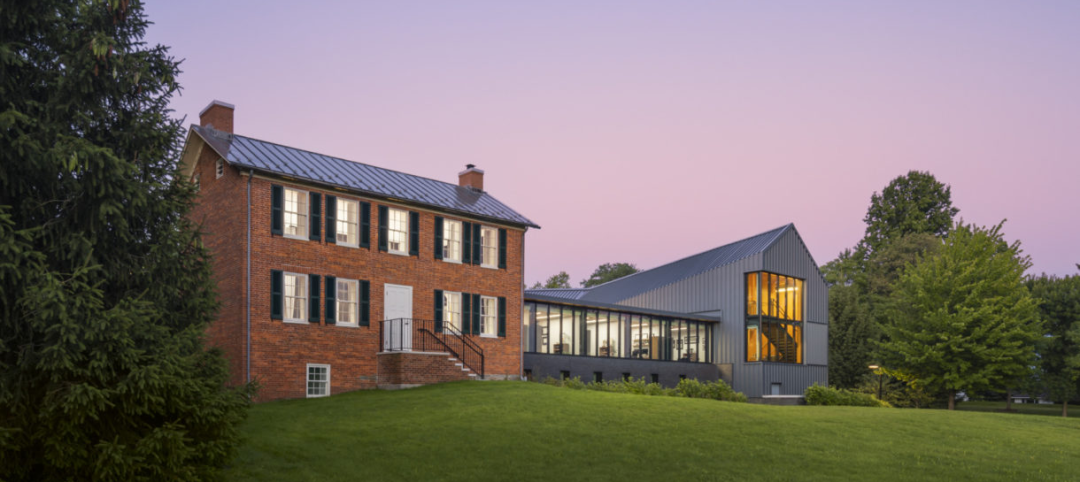The American Institute of Architects (AIA) today announced its “punch list” for Congress that, if completed, will ignite the construction economy by spurring much needed improvements in energy efficiency, infrastructure and resiliency and create jobs for small business
“America needs to create more jobs, to strengthen communities, and find help for millions of young people to succeed in the new economy,” said Robert Ivy, CEO of the American Institute of Architects, "so we've created a punch list—a term that enumerates unfinished items in a construction contract."
“The AIA’s Congressional punch list will help Congress satisfy its implicit contract with the American people to spur growth and create jobs,” Ivy said. “Our legislative agenda reflects the interests of our members, which not so coincidentally reflects the priorities of the American people.”
“America needs to create more jobs, to strengthen communities, and find help for millions of young people to succeed in the new economy,” said Robert Ivy, CEO of the American Institute of Architects. A punch list is a list of actions that need to be taken to satisfy the terms of a contract.
“The AIA’s Congressional punch list will help Congress satisfy its implicit contract with the American people to spur growth and create jobs,” Ivy said. “Our legislative agenda reflects the interests of our members, which not so coincidentally reflects the priorities of the American people.”
The AIA’s Punch List for Congress:
1. Re-enact Expired Energy Efficiency Tax Incentives
Congress left town in December without extending several important tax incentives that expired on New Year’s Day. Of most significance to the design and construction industry is the expiration of a tax break enacted in 2005 for energy efficient commercial buildings. The 179D deduction allowed building owners to claim a tax deduction of $1.80 per sq. ft. of building area to install systems that reduce the total energy and power costs by 50 percent or more when compared with a reference building. As Congress continues to debate long-term tax reform, it can boost the economy and create jobs today by reinstating this deduction.
2. Help Businesses by Reforming Government Procurement Rules
More than 97 percent of architecture firms employ 50 or fewer people; every project they design leads to job opportunities for millions of construction workers. But too many laws and regulations block innovative solutions that maximize the government’s return on its investment. Congress must reform procurement rules so that architects and designers can deliver projects that are safe, productive and sustainable. In 2014, the AIA is aggressively pushing for passage of The Design-Build Efficiency and Jobs Act of 2013 (H.R. 2750), introduced by Rep. Sam Graves (R-MO) in July, which would reform of the design-build contracting process so that more design and architectural firms can bid on federal contracts without fear of losing money in the process.
3. Invest in the Next Generation of Design Leaders
Millions of young people aspire to help their communities build a better future – but a lack of opportunity and the crushing cost of education hold them back. As a result, the design and construction industry faces a severe shortage of talent, at exactly the moment we need to start rebuilding for the future. The AIA urges Congress to pass the proposed National Design Services Act (NDSA), which will give architecture students the relief from crushing student loan debt as that granted young lawyers, doctors and others – in return for pro bono community service.
4. Invest in Infrastructure
Just as the Capitol dome, the symbol of American democracy is undergoing a multi-year renovation, so too must our nation’s infrastructure. Congress should pass a multi-year transportation reauthorization, which would allow for long-term planning that not only repairs roads and bridges but helps communities prosper; and enact a National Infrastructure Bank to finance the design, construction and repair of buildings and other vital infrastructure. Such moves would help free up capital for private sector building projects, and new ways to invest in public sector buildings, providing jobs in the short term and a more competitive economy in the long run.
5. Pass a Common-Sense Energy Efficiency Bill
Last session, the Senate Energy and Natural Resources Committee approved a bipartisan bill, the Energy Savings and Industrial Competitiveness Act of 2013 that would encourage families, businesses and the government to save energy. The Senate should take up the legislation, sponsored by Ohio Republican Rob Portman and New Hampshire Democrat Jeanne Shaheen, in 2014, and oppose efforts by the fossil fuel industry to repeal existing policies that save energy.
6. Help Communities Weather Natural Disasters
Each year, natural disasters kill tens of thousands of people worldwide and inflict billions of dollars in damage. Many parts of the United States are still recovering from tornadoes and hurricanes like Superstorm Sandy. Congress can help communities fortify themselves from such disasters by passing the Safe Building Code Incentive Act, introduced by New Jersey Democratic Senator Robert Menendez and Florida Republican Congressmen Mario Diaz-Balart, which encourages states to voluntarily adopt and enforce nationally recognized model building codes.
About The American Institute of Architects
Founded in 1857, members of the American Institute of Architects consistently work to create more valuable, healthy, secure, and sustainable buildings, neighborhoods, and communities. Through nearly 300 state and local chapters, the AIA advocates for public policies that promote economic vitality and public well being. Members adhere to a code of ethics and conduct to ensure the highest professional standards. The AIA provides members with tools and resources to assist them in their careers and business as well as engaging civic and government leaders, and the public to find solutions to pressing issues facing our communities, institutions, nation and world. Visit www.aia.org.
Related Stories
Roofing | Jan 8, 2024
Researchers devise adaptive roof tile concept that adjusts to ambient temperatures
Scientists at the University of California Santa Barbara published a paper that proposes adaptive roof tile technology that can adjust to ambient temperatures. Using a wax motor, tiles could switch from a heating or cooling state enabling savings on heating and cooling costs.
MFPRO+ News | Jan 4, 2024
Bjarke Ingels's curved residential high-rise will anchor a massive urban regeneration project in Greece
In Athens, Greece, Lamda Development has launched Little Athens, the newest residential neighborhood at the Ellinikon, a multiuse development billed as a smart city. Bjarke Ingels Group's 50-meter Park Rise building will serve as Little Athens’ centerpiece.
MFPRO+ Special Reports | Jan 4, 2024
Top 10 trends in multifamily rental housing
Demographic and economic shifts, along with work and lifestyle changes, have made apartment living preferable for a wider range of buyers and renters. These top 10 trends in multifamily housing come from BD+C's 2023 Multifamily Annual Report.
Giants 400 | Jan 3, 2024
Top 200 Reconstruction Architecture Firms for 2023
Gensler, Stantec, HDR, Corgan, and PBK Architects top BD+C's ranking of the nation's largest building reconstruction/renovation architecture and architecture engineering (AE) firms for 2023, as reported in the 2023 Giants 400 Report.
Designers | Jan 3, 2024
Designing better built environments for a neurodiverse world
For most of human history, design has mostly considered “typical users” who are fully able-bodied without clinical or emotional disabilities. The problem with this approach is that it offers a limited perspective on how space can positively or negatively influence someone based on their physical, mental, and sensory abilities.
Giants 400 | Jan 2, 2024
Top 120 Hotel Architecture Firms for 2023
Gensler, WATG, HKS, DLR Group, and HBG Design top BD+C's ranking of the nation's largest hotel and resort architecture and architecture/engineering (AE) firms for 2023, as reported in Building Design+Construction's 2023 Giants 400 Report.
Resiliency | Jan 2, 2024
Americans are migrating from areas of high flood risk
Americans are abandoning areas of high flood risk in significant numbers, according to research by the First Street Foundation. Climate Abandonment Areas account for more than 818,000 Census Blocks and lost a total of 3.2 million-plus residents due to flooding from 2000 to 2020, the study found.
MFPRO+ News | Jan 2, 2024
New York City will slash regulations on housing projects
New York City Mayor Eric Adams is expected to cut red tape to make it easier and less costly to build housing projects in the city. Adams would exempt projects with fewer than 175 units in low-density residential areas and those with fewer than 250 units in commercial, manufacturing, and medium- and high-density residential areas from environmental review.
Contractors | Dec 22, 2023
DBIA releases two free DEI resources for AEC firms
The Design-Build Institute of America (DBIA) has released two new resources offering guidance and provisions on diversity, equity, and inclusion (DEI) on design-build projects.
MFPRO+ News | Dec 22, 2023
Document offers guidance on heat pump deployment for multifamily housing
ICAST (International Center for Appropriate and Sustainable Technology) has released a resource guide to help multifamily owners and managers, policymakers, utilities, energy efficiency program implementers, and others advance the deployment of VHE heat pump HVAC and water heaters in multifamily housing.

















